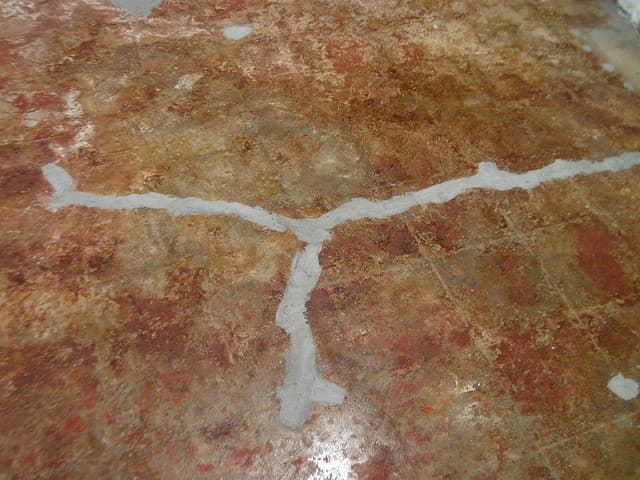Are you looking for a contractor?
Submit our quick form and get quotes now!
Table of Contents
6 min read
What are pyrite and pyrrhotite and how do you deal with them?


6 min read
What are pyrite and pyrrhotite and how do you deal with them?
FlooringWhat are pyrite and pyrrhotite and how do you deal with them?
Pyrite is an iron sulphide, known as “fool’s gold” whose crystallization shimmers with gilded reflections. If the brilliance of this worthless mineral deceived gold prospectors of their time, its oxidization when in contact with moisture and oxygen, producing sulfuric acid, stirs up a bitterness in many owners today. The presence of pyrite or of pyrrhotite underneath a foundation may cause the slab of concrete of the house to rise and crack.
In some parts of Quebec and the United States, the problem is so widespread that citizen rallies have been organized so that people who are affected can come together to find solutions and put pressure on governments to receive help.
The difference between pyrite and pyrrhotite
Before we dig deeper into the subject, it is important to determine the difference between pyrite and pyrrhotite that are sometimes confused. Here are the definitions presented on the Régie du Bâtiment du Québec website:
" Pyrite is a mineral which is found in stone and produces sulfuric acid when it oxidizes upon contact with humidity and oxygen. When this phenomenon occurs under foundations, it can cause the heaving and cracking of the concrete slab.
Pyrrhotite is a mineral species composed of iron sulfide and is of a bronze yellow color, blackening when exposed to air. When it crystallizes in blades, pyrrhotite can produce cracks in the concrete structures."
Source: R.B.Q.
Why is pyrite or pyrrhotite present under the house?
When excavating a piece of land to pour the concrete foundations of a dwelling, the area is not totally flat. This is why we spread the fill, a mass of material used to elevate the ground. Except for using the fill commonly known as“DB certificate”, it is possible that this material contains the particles from harmful minerals.
If the pyrite oxidizes upon contact with moisture, it forms gypsum crystals which increase the volume of the fill. “It’s like a ball of dough in the oven. It expands in every direction”, illustrates Guy Forest founder of Multitest in La Presse of September 13, 2014.
Under the garage, pyrite pushes upwards and extends towards the sides, which can damage the foundations of the house.

The quality of the fill isn’t uniquely determined by the presence or absence of these two minerals in the material. Certain types of stone such as clay shales react more to the oxidization of iron sulphate. When in contact with moisture and oxygen, the swelling of pyrite is amplified by these types of stones.
How to check for pyrite?
In the case of building a new home, you must ensure the fill being used is DB certified. According to the Association des consommateurs pour la qualité dans la construction (ACQC), the CTQ-M100 standard, which aims at certifying the non-inflating quality of fills used in construction, is not mandatory.
“The use remains on a voluntary basis. Unfortunately, we still see contractors who put a part of the uncertified fill just to save a dollar or two a ton” deplored Guy Forest, founder of Multitest in La Presse of September 13, 2014.
In the case of a buyback or in case you have doubts if your property is more than 10 years old, you can have the fill of your house and garage checked. The standardized tests determine the type of stone and its Petrographic Index Swelling Potential (PEPI). In the case of swelling or cracks, you can order a chemical analysis of the fill which will indicate if the pyrite has completed its reaction.
According to the ACQC, there is no method for neutralizing the effect of oxidation. The best way to get rid of pyrite problems is to break the concrete slab, remove all the fill and concrete debris and make a new slab on good quality fill afterwards. Demolishing a slab in the garage and replacing its fill is less costly than carrying out the same operation in the basement.
Take into consideration that the basement area is larger than that of the garage. In addition, access to excavation equipment is much more difficult. This work requires the demolition and reconstruction of the existing partitions. Before embarking on this costly project, make sure to assess the extent of the damage well.
Follow the progression of the swelling by taking note of the date and length of the crack, measure the fracture on one side or the other of the crumbling crack. Make a sketch or take pictures of the issues for proof of swelling when consulting an expert.
If there is pyrite in your home...
According to the ACQC, sellers who get an appraisal to determine the potential for swelling of the fill may have to deal with the presence of pyrite. If so, the value of the house could decrease even if the slab can remain intact. On the other hand, if you sell a house without mentioning the presence of pyrite, you may receive a formal notice 3, 5, 10 or even 30 years down the line.
Selling without a legal warranty exempts you from these responsibilities. While the warranty is legal, the warranty plan for new residential buildings expires 5 years after you take possession of your home.
The government of Quebec has put in place a program designed to help owners of residential buildings damaged by pyrite to help the homeowners to make the necessary adjustments. The government of Quebec assumes 62.5% of the financial assistance granted, the government of Canada contributes 25%, and municipalities are invited to participate by contributing up to 12.5%. Some municipalities also offer aid. For more information, consult the ACQC guide “Pyrite and your house”.
Although the problem can begin under the garage, pushing upwards and extending to the sides and damaging the foundation of the house, the government program only applies to the residential part of the building. Therefore, a garage is not eligible, considered a space without a residential function.
Is pyrite harmful to your health?
Unlike asbestos and the old lead pipes that are being removed from homes, pyrite and pyrrhotite are not harmful to your health. The quantities of sulfuric acid are too negligible to cause health problems, according to the Monteregie Department of Public Health.
However, cracks in the slab or foundation’s walls could increase the moisture content in the basement leading to the developing of moulds that can be detrimental to one’s health.
Get 3 renovation quotes to address problems related to pyrite in your house
RenoQuotes.com will put you in contact with 3 reliable contractors to get quotes to counter pyrite swelling. Fill in the form on our homepage (it only takes a few minutes), and you will receive quotes from trusted professionals.
Dial 1-844 828-1588 to speak with one of our customer service representatives
Last modified 2023-11-07
Looking for something else?
Related articles
The latest industry news, interviews, technologies, and resources.

Cynthia Pigeon • 07 Nov 2023
With the new year ahead, major developments are being ushered into the renovation industry.

Amanda Harvey • 07 Nov 2023
Hygge, pronounced phonetically as "hoo-gah," is a concept that originated in Denmark but has made its' way to the renovation and interior design networks of North America. Hygge roughly translates to "coziness," but is often described as a mindset for fostering positivity and togetherness in negative aspects of life; an attempt to enjoy the smallest and most insignificant moments.

Léa Plourde-Archer • 11 Apr 2024
Generally speaking, the interior or exterior painting of surfaces in a residential home will need to be renewed every 4 to 5 years, depending on the humidity level, the penetration of sun rays (which discolour surfaces) and the general layout of your home. Painting is one of the best ways to keep your home looking nice and modern.

Cynthia Pigeon • 07 Nov 2023
Are you in the process of building your new home but are lacking key information regarding ceiling heights?

Cynthia Pigeon • 07 Nov 2023
Mould found in homes is a common concern amongst many homeowners because of the extensive damage it can cause.